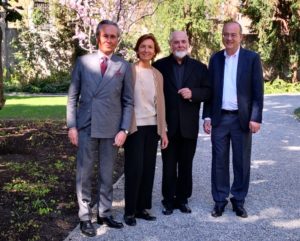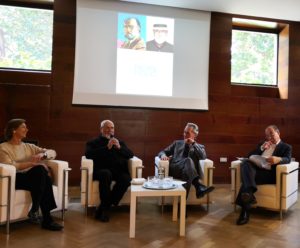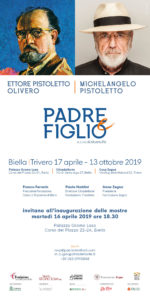From Wednesday 17th April to Sunday 13th October 2019, Biella and Trivero will host Padre e Figlio (Father and Son), a scattered exhibition curated by Alberto Fiz placing in dialogue the artistic production of Michelangelo Pistoletto (Biella, 1933) with that of his father Ettore Pistoletto Olivero (Arnodera, Val di Susa, 1898 – Sanremo, 1981). The exhibition (developed by Cassa di Risparmio di Biella, Cittadellarte and Fondazione Zegna) spreads across three iconic venues in the Biellese territory: Palazzo Gromo Losa, historic stately home restored and made available to the city by Fondazione Cassa di Risparmio di Biella, Cittadellarte – Fondazione Pistoletto and Casa Zegna, site of the historic archives and exhibition space of Fondazione Zegna. The works of Michelangelo Pistoletto and those of his father Ettore, esteemed painter of landscapes and still lifes, represent the starting point of a close debate on the topic of the relationship father – son, declined into many of its implications and nuances. Through the works on display and the video-dialogues created with the curator and Anna Zegna, Michelangelo Pistoletto has given expression to a non-unidirectional conception of the father – son relationship: leaving an inheritance to the fathers, rather than entrusting only the children with the responsibility to communicate the knowledge and the passions of the parents. The mirroring theme emerging from this vision of the parental relationship (which in this case coincides with the relationship between master and student) is manifested in the articulated – and sometimes provocative – juxtapositions presented throughout the exhibition. “The rich and diverse display allows for a multi-level reading into an extremely topical theme; – says Alberto Fiz – starting from a dialogue between Michelangelo Pistoletto and his father, we can reflect on the concepts of historical and subjective time, but also on the need to accept differences which can even lead to an intimate empathy”.

Picture taken today – 19th March – after the press conference presenting the exhibition Padre e Figlio. From the left: Franco Ferraris, president of Fondazione CR Biella; Anna Zegna, president of Fondazione Zegna; Michelangelo Pistoletto; Alberto Fiz, curator of the exhibition.
Padre e Figlio will feature over a hundred works including paintings, mirror paintings, installations, lightboxes, videos and photographs, and it’s held in an extremely meaningful year for the city of Biella, which in 2019 has presented its candidature for the UNESCO Creative Cities Network, with Michelangelo as the official ‘ambassador’ for the project. The artist from Biella has in fact created a symbol of the Third Paradise dedicated to the nomination, and has had his Rebirth ambassadors around the world subscribe the manifesto supporting it. Biella, an active manufacturing hub where modern industry carries on a centuries old tradition passed down from father to son, is a virtuous example of how art and business can collaborate, not only in favour of the local economy, but also committing to creating places of aggregation and culture. The theme of the exhibition is closely intertwined with the deep connection between Ettore and Michelangelo and the city and the Zegna family, clients of the Pistolettos since 1929, when Ermenegildo, the founder of the company, commissioned from Ettore the cycle of graffiti The Art of Wool. Today, Fondazione Zegna is partner in many of Cittadellarte’s initiatives, among which the project Visible and UNIDEE – University of Ideas. This event represents the conclusion of an ideal trilogy of three exhibitions which have investigated the relationship between Michelangelo Pistoletto and his father, starting in 1973 with the show of the same name (Padre e Figlio) at the Gian Enzo Sperone Gallery in Turin, followed by Ettore e Michelangelo. I coetanei (Ettore and Michelangelo. Equal in age), also held in Turin, at the Persano Gallery.
Padre e Figlio is articulated in three displays housed in three historical and iconic venues in the Biellese territory, generating one big exhibition.
The exhibition path – Palazzo Gromo Losa
Palazzo Gromo Losa, which – together with Palazzo La Marmora and Palazzo Ferrero – represents the cultural hub of Biella Piazzo, is the venue hosting the first part of the exhibition, centred on a mirroring between Ettore’s and Michelangelo’s works. After an introduction dedicated to the themes of portrait and self-portrait (also on display Michelangelo Pistoletto’s Il presente. Uomo di fronte – The present. Man seen from the front –, from 1961), the exhibition places in dialogue Ettore’s still lifes with a pivotal series of mirror paintings realized between 1963 and 2017 by Michelangelo Pistoletto, among which is Padre e madre (Father and mother), from 1968, representing his parents seen from the back.
Many are the elements of reflection in an inexhaustible dialogue which goes beyond the relationship between two artists to become extremely iconic and symbolic. To confirm that is L’arte assume la religione (Art assumes religion), from 1980, a big and rarely exhibited work coming from the Mart (Rovereto’s Museum of Modern Art). At the centre of a canvas is another work by Michelangelo Pistoletto, Autoritratto attraverso mio padre (Self-portrait through my father), from 1973, a silkscreen print representing the face of a child drawn in pencil. This drawing is the portrait of a three-month old Michelangelo Pistoletto by his father. It is a conceptual work of re-appropriation, in which the artist uses his own father as an instrument of knowledge. The complete work includes 31 aphorisms written in an hour and published by Lucio Amelio in 1977 (the first one is Lasciare un’eredità ai padre – Leaving an inheritance to the fathers -). This series was the opportunity for the realization of a particularly suggestive new sound installation featuring the voice of Michelangelo Pistoletto. This work now presented at Palazzo Gromo Losa was part of an installation designed for the 9th edition of Documenta in Kassel in 1992.
But the actual interaction on the theme of mirroring develops around Ettore Pistoletto Olivero’s still lifes. In 1973, on the occasion of the exhibition at the Speroni Gallery, it is Michelangelo who points his father in the right direction thus becoming his master. It’s he who invites him to represent compositions including – together with daily objects – mirroring elements like bottles, pots, urns, or the tables they are placed on. In this context, his father becomes himself subject of the composition, as clearly shown by his image reflected on the silver vase. This same action will be carried out in 2008 by Michelangelo, at the age of 76, as old as his father was in 1973. Father and son, through art, do become the same age, as visible on a lightbox from that year, representing both of them at 76. We can perceive a further dialogue in time and space in the installation Mobili capovolti (Upside down furniture), from 1976, and in the photograph referring to another famous installation from that year, I mobili dello studio di mio padre nel mio studio (Furniture from my father’s studio in my studio), in which the artist inhabits the domestic space of his father.
The exhibition path – Casa Zegna
The display at Casa Zegna, in Trivero, is mainly a ‘homage’ to Ettore Pistoletto Olivero: inside the building, in an evocative setup, two of his paintings from 1952-1953 are exhibited for the first time. They represent different stages of the construction of Panoramica Zegna, an extraordinary environmental route commissioned by Ermenegildo Zegna today part of the natural park of Oasi Zegna. The canvas are placed in dialogue with historic photographs of the time. At the centre of the room is a new version of Michelangelo Pistoletto’s big installation Metamorphosi (Metamorphoses), from 1976, in which a pile of rags and used clothes is divided into two by a double mirror. In this instance, the artist seems to metaphorically repossess the landscapes of his father developing a new spatial-temporal content. The adjacent wool mill houses Ettore’s most important cycle of paintings, the series of ten canvas L’Arte della Lana (The art of wool) on mobile panels, realized between 1947 and 1949, which are the reproduction on fabric of the earlier cycle of wall graffiti of the same name painted by Ettore in the 1930s and destroyed in the course of the renovation of the building.
The exhibition path – Cittadellarte
The itinerary of the exhibition concludes at Cittadellarte – Fondazione Pistoletto, where the starting point is Padre, figlio e creatività (Father, son and creativity), one of the installations from the cycle Le Stanze (The rooms), conceived in 1975 for the Christian Stein Gallery. “First of all I placed the word ‘son’ on each section of wall above the openings between the rooms, – commented Pistoletto – because I am looking at the work from the son’s point of view. The word ‘son’ repeats itself above the openings all the way to the threshold to the last room. But here the illusion fails, in front of us is a mirror and not a continuation of rooms, because in the reflection is the word ‘father’ that continues from room to room”. Together with this emblematic installation, a multimedia display presents the projects Visible and UNIDEE, separated by a series of portraits by Ettore among which is Le tre figlie di Zegna (Zegna’s three daughters), a family group painted in 1929 coming from Mart and on display for the first time, and short video clips on the relationship father – son realized through a public call among Biellese citizens.
The exhibition is accompanied by three video interventions realized specifically for the event: Autoritratto attraverso mio padre (Self-portrait through my father), a dialogue between Michelangelo Pistoletto and Alberto Fiz; Lasciare un’eredità ai padri (Leaving an inheritance to the fathers), a conversation between Pistoletto and Anna Zegna on the relationship between their respective families and the link between art and business; and L’Arte della Lana (The art of wool), in which Pistoletto, together with Anna Zegna, makes a comparison between traditional wool working techniques and the present productive process, taking the lead from Ettore Pistoletto Olivero’s cycle of paintings of the same name.

Press conference of the exhibition Padre e Figlio. In the picture, from the left: Anna Zegna, president of Fondazione Zegna; Michelangelo Pistoletto; Franco Ferraris, president of Fondazione CR Biella; Alberto Fiz, curator of the exhibition.
The catalogue
The substantial monographic catalogue, published by Magonza in Italian and in English, wants to reach beyond the contingency of the event presenting contributions engaging on the theme of the relationship father – son from different points of view, from psychoanalysis to sociology, from cinema to theatre, also reflecting on the generational transitions of businesses. The volume includes an iconographic apparatus illustrating all the works on display across the three venues, an essay by the curator Alberto Fiz, the transcripts of the dialogues of Anna Zegna and Fiz himself with Michelangelo Pistoletto, and texts by Alessandro Bergonzoni, Piero Chiara, Paolo Cognetti, Nicoletta Colombo, Johnny Dotti, Ferruccio De Bortoli, Piercarlo Grimaldi, Paolo Naldini (director of Cittadellarte), Grazia Paganelli (from the National Museum of Cinema in Turin) and Massimo Recalcati.
The rich programme of activities includes conferences with the participation of important figures from the worlds of culture and business, didactic workshops for schools and a film festival in collaboration with the National Museum of Cinema in Turin curated by Stefano Boni and Grazia Paganelli.
Practical information – tickets
Ticket prices (three venues): Full price €10,00; Concessions €7,00 (over 65, 18-25 year olds, university students, groups of min.12 people, FAI members, Amici di Castelli Aperti members, Plein Air members, Azimut employees, Biver Banca employees, Banca di Asti employees, FCA employees); Free for under 18, disabled and their carer, Abbonamenti Musei Torino Piemonte card holders, tour leaders, teachers accompanying a class, registered journalists, registered tour guides, Museo Banca di Asti voucher holders, Zegna employees, Consorzio Alpi Biellesi members. Special deal Padre e figlio: €7,00 for two people. Tickets available for purchase on line at www.liveticket.it padreefiglio.
Practical information – opening times
Palazzo Gromo Losa: Friday 15.00-19.00; Saturday and Sunday 11.00-19.00 (outside these hours by booking only for groups of min. 5 people – cost of the visit €75,00 + admission tickets); Casa Zegna: Saturday 15.00-19.00; Sunday 11.00-19.00; Tuesday, Wednesday, Thursday and Friday 10.00-17.00; Saturday 11.00-15.00 by booking only (groups of max. 25 people – cost of the visit €90,00 + admission tickets); Cittadellarte: Saturday and Sunday at 11:00, 14:30 e 16:30; Tuesday, Wednesday, Thursday and Friday 10.00-17.00 by booking only (for groups of min. 5 people). Special bank holiday openings: 17th, 18th e 19th April (15.00-19.00); 22nd April (Easter Monday), 25th April, 1st May, 2nd June and 15th August (11.00-19.00). Closed on Sunday 21st April (Easter).
The exhibition was made possible also by the contribution of Compagnia di San Paolo and the support of Azimut, main sponsor of the project. Biver Banca – Gruppo Cassa di Risparmio di Asti is the sponsor of the initiative.


